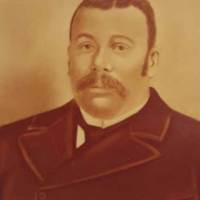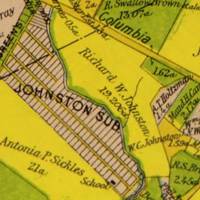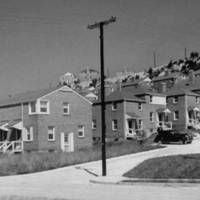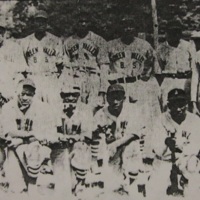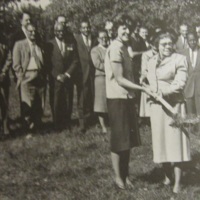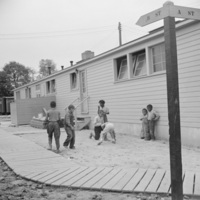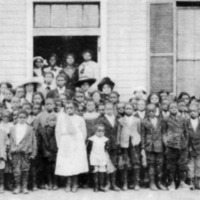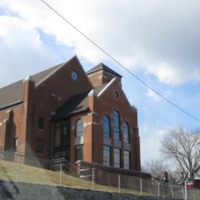Browse Items (28 items total)
Henry Louis Holmes was an early leader in Arlington's African American community. Enslaved before the Civil War, Holmes was drawn to Arlington by Freedman's Village. While little is known about his early life, after the war Holmes served as a leader in the Radical Republican political party, was active in the black community through the Mason and Odd Fellow fraternal organizations, and served as a trustee for St. John's Baptist Church. In 1882 he helped to found the Butler-Holmes community, where he lived with his wife Emma and their children.
Collection: Neighborhoods
William H. Butler was an early leader in Arlington's African American community. Butler, his wife Anne, and their four children were enslaved before the Civil War. They were drawn to Arlington by the Freedman's Village contraband camp. He served in the Union Army from 1863 to 1865. He served as Commissioner of Roads in 1879, as Surveyor of the Roads and Superintendent of the Poor throughout the 1880s, and he was the co-founder of the Butler-Holmes black neighborhood in 1882. The Butler family lived in the family home, pictured here, in that community into the modern era.
Collection: Neighborhoods
The Johnson's Hill community was founded in 1880 when the white Johnston family began selling lots to African Americans leaving Freedman's Village. Early settlers included Harrison Green, Emmanus Jackson, and Harry W. Gray. These men were leaders in the African American community, helping to found the important United Order of Odd Fellows fraternal organization in the neighborhood.
The community is located on a hill along Columbia Pike, near both Arlington National Cemetery and Fort Myer. Today the area is known as Arlington View.
The community is located on a hill along Columbia Pike, near both Arlington National Cemetery and Fort Myer. Today the area is known as Arlington View.
Collection: Neighborhoods
First established in 1844 by freemen Sarah and Levi Jones, Green Valley is Arlington's oldest African American community. By 1900 this neighborhood in eastern Arlington County became the largest black community in terms of both geography and population. This large population supported both a church and school within the community. The early strength of Green Valley was due, in large part, to the presence of the Jones family who actively sold land to fellow African Americans. The image above shows the community in the 1970s. At that time the community became known as Nauck.
Collection: Neighborhoods
At the turn of the last century baseball was such a popular sport in Arlington that the county supported as many as five semi-professional teams. Like most elements of life at the time, sports and recreation were segregated.
Beginning in the 1910s, Arlington's black community formed the Black Socks Baseball team, pictured here. From their home base of Peyton Field in the Nauck community (formerly Green Valley). the Black Socks toured the east coast playing other black teams.
Beginning in the 1910s, Arlington's black community formed the Black Socks Baseball team, pictured here. From their home base of Peyton Field in the Nauck community (formerly Green Valley). the Black Socks toured the east coast playing other black teams.
Collection: Community Institutions
In 1946 Arlington's African American community leaders began fundraising for the Veteran's Memorial Branch YMCA. Recreational facilities, including those sponsored by the existing YMCA, were segregated along racial lines at the time. Spearheaded by life-long activist and community resident Edmund Fleet, the Veteran's Memorial Branch YMCA opened in 1949.
It sponsored social and recreational activities for Arlington's black youth. In the 1960s, a pool was added to the facility so Arlington's black youth would finally have a safe place to swim in the county. This photograph shows the groundbreaking for the swimming pool.
It sponsored social and recreational activities for Arlington's black youth. In the 1960s, a pool was added to the facility so Arlington's black youth would finally have a safe place to swim in the county. This photograph shows the groundbreaking for the swimming pool.
Collection: Community Institutions
In 1942 the federal government created emergency wartime housing to assist African American residents from Queen City displaced by the construction of the Pentagon. They constructed a trailer camp on mud flats on the outskirts of the Green Valley neighborhood. Entire families squeezed into trailers equipped with stoves for heat and cooking, convertible couch-beds meant to sleep four people, and no running water. The trailer camp was closed shortly after the war.
Collection: Neighborhoods
This woodcut, featured in Harper's Weekly in 1864, depicts Freedman's Village. A contraband camp established on the grounds of Arlington House, Robert E. Lee's plantation, Freedman's Village was Arlington's first all black community as well as its first successful pre-planned community. Here formerly enslaved men, women, and children learned trades, attended school, established churches, and create a thriving African American community. When the Village was formally closed by the federal government in 1900 it lead to the establishment of many other black communities in Arlington through the Freedman's Village diaspora.
Collection: Neighborhoods
Kemper School was the African American school for the the Green Valley community, Kemper opened in 1875 within Green Valley's AME Zion Church. Upon it's opening, Kemper was one of three schools for African American children, joining schools in the black communities of Hall's Hill and Freedman's Village.
In 1885 the school moved to a one-story, wood-frame school house on 3/4 of an acre of land. The school was named for Virginia Governor James L. Kemper who supported education for African Americans. By 1893 the school had outgrown its original structure and a new brick, two-story school house was created by Noble Thomas, the first black contractor in the county. In 1944 the school expanded further with the addition of the Kemper Annex, which was renamed Drew in 1955 in honor of leading African American blood plasma researcher and Arlington resident Dr. Charles Drew.
In 1964 Kemper ceased to function as a school, replaced by the larger Drew School. The building was demolished in the 1980s to make room for partially subsidized town-homes.
In 1885 the school moved to a one-story, wood-frame school house on 3/4 of an acre of land. The school was named for Virginia Governor James L. Kemper who supported education for African Americans. By 1893 the school had outgrown its original structure and a new brick, two-story school house was created by Noble Thomas, the first black contractor in the county. In 1944 the school expanded further with the addition of the Kemper Annex, which was renamed Drew in 1955 in honor of leading African American blood plasma researcher and Arlington resident Dr. Charles Drew.
In 1964 Kemper ceased to function as a school, replaced by the larger Drew School. The building was demolished in the 1980s to make room for partially subsidized town-homes.
Collection: Community Institutions
Mount Zion Baptist Church is a brick structure which features a gabled roof and right form tower.
The church congregation was originally founded within the Old Bell Church in Freedman's Village in 1866. In the late-1860s the Old Bell Church was demolished and the church split into two congregations - Mt. Olive and Mt. Zion Baptist churches. Both formed in the community of Queen City. In 1942 the federal government condemned the church and surrounding community to make way for the road networks of the Pentagon. The congregation moved to Green Valley where they opened the current church in July on 1945.
The church congregation was originally founded within the Old Bell Church in Freedman's Village in 1866. In the late-1860s the Old Bell Church was demolished and the church split into two congregations - Mt. Olive and Mt. Zion Baptist churches. Both formed in the community of Queen City. In 1942 the federal government condemned the church and surrounding community to make way for the road networks of the Pentagon. The congregation moved to Green Valley where they opened the current church in July on 1945.
Collection: Community Institutions
